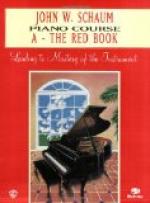“For the first five years of my musical experience, I simply played the piano. I played everything—sonatas, concertos—everything; large works were absorbed from one lesson to the next. When I was about twelve I began to awake to the necessity for serious study; then I really began to practise in earnest. My master took more and more interest in my progress and career: he was at pains to explain the meaning of music to me—the ideas of the composers. Many fashionable people took lessons of him, for to study with Pugno had become a fad; but he called me his only pupil, saying that I alone understood him. I can truly say he was my musical father; to him I owe everything. We were neighbors in a suburb of Paris, as my parents’ home adjoined his; we saw a great deal of him and we made music together part of every day. When he toured in America and other countries, he wrote me frequently; I could show you many letters, for I have preserved a large number—letters filled with beautiful and exalted thoughts, expressed in noble and poetic language. They show that Pugno possessed a most refined, superior mind, and was truly a great artist.
“I studied with Pugno ten years. At the end of that time he wished me to play for Emil Saur. Saur was delighted with my work, and was anxious to teach me certain points. From him I acquired the principles of touch advocated by his master, Nicholas Rubinstein. These I mastered in three months’ time, or I might say in two lessons.
“According to Nicholas Rubinstein, the keys are not to be struck with high finger action, nor is the direct end of the finger used. The point of contact is rather just back of the tip, between that and the ball of the finger. Furthermore we do not simply strive for plain legato touch. The old instruction books tell us that legato must be learned first, and is the most difficult touch to acquire. But legato does not bring the best results in rapid passages, for it does not impart sufficient clarity. In the modern idea something more crisp, scintillating and brilliant is needed. So we use a half staccato touch. The tones, when separated a hair’s breadth from each other, take on a lighter, more vibrant, radiant quality; they are really like strings of pearls. Then I also use pressure touch, pressing and caressing the keys—feeling as it were for the quality I want; I think it, I hear it mentally, and I can make it. With this manner of touching the keys, and this constant search for quality of tone, I can make any piano give out a beautiful tone, even if it seems to be only a battered tin pan.
TONE WHICH VIBRATES THROUGH THE WHOLE BODY
“Weight touch is of course a necessity; for it I use not only arms and shoulders, but my whole body feels and vibrates with the tones of the piano. Of course I have worked out many of these principles for myself; they have not been acquired from any particular book, set of exercises, or piano method; I have made my own method from what I have acquired and experienced in ways above mentioned.




